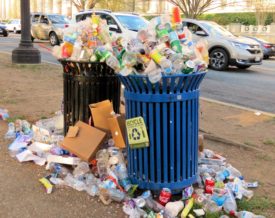 More than 200 toxic chemicals were found in the blood of umbilical cords sampled from racial and ethnic minority babies, according to a report coming out Wednesday. The analysis discovered for the first time in cord blood bisphenol A (or BPA), a perfluorocarbon used in non-stick and weather-proofing products, as well as certain forms of PCBs and synthetic fragrances.
More than 200 toxic chemicals were found in the blood of umbilical cords sampled from racial and ethnic minority babies, according to a report coming out Wednesday. The analysis discovered for the first time in cord blood bisphenol A (or BPA), a perfluorocarbon used in non-stick and weather-proofing products, as well as certain forms of PCBs and synthetic fragrances.
Yuck. Remember this is measuring exposure to fetuses, the most vulnerable time for most stages of human development.
The study comes from the Environmental Working Group, a nonprofit group that’s made a name for itself by testing people for pollutants, and was done in partnership with Rachel’s Network. The group sampled was admittedly small—10 babies of African American, Hispanic, and Asian descent. But it took a look at a large range of pollutants found in consumer goods.
The research adds to a recent study from the Washington Toxic Coalition that analyzed blood and urine samples from nine pregnant women in Washington, Oregon, and California. It looked for 23 chemicals and found 13, including BPA and a PFC.
Lately, BPA has, in particular, been in the hot seat for those concerned about toxic ingredients in everyday goods. The chemical is used in hard, clear, glasslike plastics including baby and sports bottles, eye glass lenses, CDs, and in the lining of tin cans. BPA is an endocrine disruptor that can mess with hormone function and potentially cause different kinds of cancer.
If any of this interests you even remotely, check out the study, titled “Pollution in People: Cord Blood Contaminants in Minority Newborns.” It’s easy to read and well organized, gives great background on the chemicals tested for, and provides perspective on how this study fits into work being done by the Centers for Disease Control and Prevention, which is also documenting pollutants in people (but neglects newborns, babies, and toddlers). It takes care to give needed caveats about the small sample size, the lack of information about exposure routes, or conclusions about what sort of risk the chemicals pose at the levels being detected in cord blood. But at least it lets us know the chemicals are there.
So what’s to be done to shield people of all ages from these toxic chemicals? At the moment, not enough. US regulations are lax, forcing states to try to crack down. However, Canada is a leader in efforts to reduce the use of BPA, declaring the chemical to be “toxic” and prohibiting its use in baby bottles.
For more on toxic chemicals and regulations—particularly BPA—check out the amazing series of articles from the Milwaukee Journal Sentinel.
UPDATE, Dec. 8:
Bill Walker of the Breast Cancer Fund offers this update with information on potential action from lawmakers and the FDA:
The Ban Poisonous Additives Act of 2009 by Sen. Dianne Feinstein of California and Rep. Edward Markey of Massachusetts would ban BPA in all reusable food and beverage containers, such as baby bottles, sports water bottles and food storage containers, and all food and beverage packaging including canned food, infant formula, and soda and water bottles. If a manufacturer can show that there are no alternatives to using BPA in a container, it must be labeled to warn consumers.
Legislation to regulate BPA-containing products has been introduced in 30 states and localities. The chemical industry, represented by the powerful American Chemistry Council lobbying group, has fought a pitched battle to block attempts to restrict BPA.
The U.S. Food and Drug Administration is finalizing a safety reassessment of BPA, which was due for release (last) week. A previous FDA study of BPA’s safety was widely criticized for its reliance on only a few chemical-industry-funded studies that found the chemical safe.
Newborn photo courtesy of Flickr user BruceLee under the Creative Commons license.






